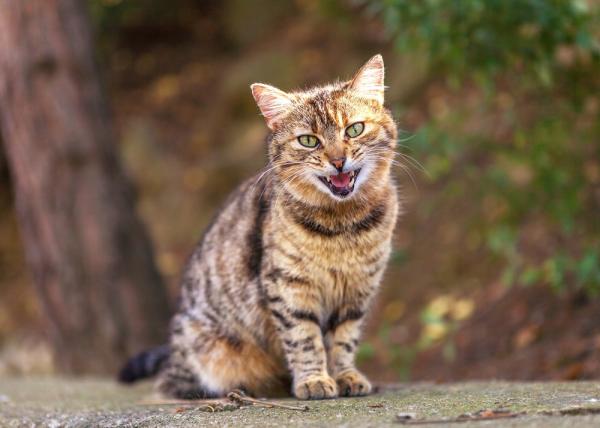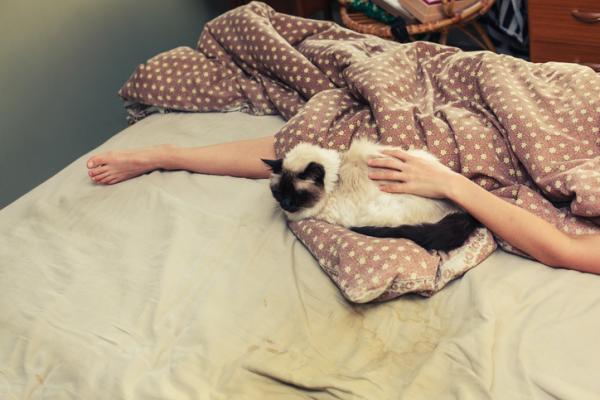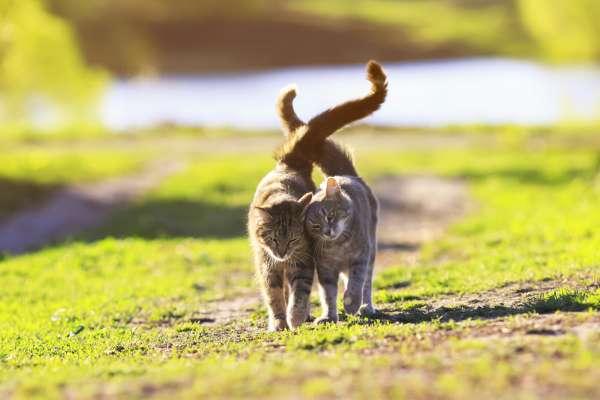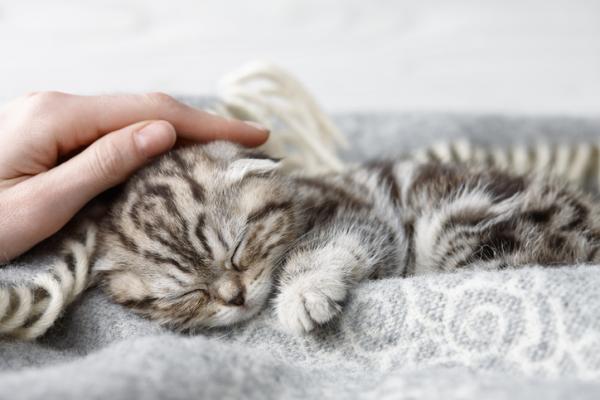11 sounds of cats and their meaning

Many tutors claim that their cats “They just need to talk”, pointing out how expressive their beautiful pussycat are. And in something they are right . Although cats do not really need to talk, they have different forms of communication, it is impressive vocalization ability that domestic cats developed. Although they mostly use their body language to express themselves, they emit different sounds that, depending on the context, may have different meanings.
You can have the absolute certainty that your pussycat is “talking” to you all the time, whether through their sounds, body postures or facial expressions. And if you want to learn to understand it better, we invite you to continue reading this new article to discover 11 sounds of cats and their meaning.
How many sounds can a cat emit?
It is a difficult question to answer even for the most expert in feline ethology. Currently, it is estimated that cats can emit more than 100 different vocalizations. However, 11 sounds appear as the most used by felines in their daily communication. Therefore, we chose to focus our article on the possible meanings of these 11 main cat sounds.
Before starting, it is important to highlight that each feline is a unique and singular individual, so that each household can have its own “dictionary of cat sounds”. That is to say: Each cat can use different sounds to get what they want or to communicate their Emotions, thoughts and moods to the other members of their environment.

1. Meow: the daily Miaow
El meow It is the most common sound of the cat and also the one that he uses most directly to get the attention of his tutors. There is no single meaning for the “Miaow” of our kittens, since their possibilities of senses are very broad. However, we can interpret what our cat wants to express paying attention to the tone, frequency and intensity of its meow, in addition to observing its body posture. As usual, the more intense is the meow of a cat, more urgent or important is the message that we want to transmit.
For example: if your pussycat keeps the same pattern of meowing for a while prolonged and it is located near your feeder, it is very likely that you are asking for food to satisfy your hunger. Already if you start to meow near a door or window, it may be asking you to go outside the house. On the other hand, a stressed or aggressive cat can emit intense meows, interspersed with grunts, and adopt a defensive posture. In addition, the cats in heat also emit a very specific meow.
2. The feline purr and its meanings
The purr is characterized as a rhythmic sound and emitted in low volume, which can have different frequencies. Although the purring of domestic cats is the most famous, wild cats also vocalize this characteristic sound. The felines purr different reasons according to their age and the reality they experience.
A “mother cat” uses purring to calm your puppies during delivery and to guide their kittens during their first days of life, when their eyes still did not open. Baby cats vocalize this sound both when they feel pleasure in suckling breast milk, and when they are afraid of unknown stimuli.
In adult cats, purring appears primarily in positive situations, where the feline feels comfortable, relaxed or happy, like eating or being caressed. However, purring is not always synonymous with pleasure. Cats can purr when they’re sick and feel vulnerable, or as a sign of fear in the face of threatening situations, such as a possible confrontation with another feline or being challenged by their guardians.
If you want to know more about purring, discover why cats purr and different meanings. You’ll love it!

3. Sounds of the cat: the chirp (or trill)
The trill or chirp is a sound similar to a “trill“, That the cat emits with its mouth closed. It is a ascending and very short vocalization, with less than 1 second. In general, this sound is more used by cats and their puppies, to communicate with each other during lactation and weaning. However, adult cats can also “thresh” for greet friendly to your loved ones.
4. The snort of the cat and its meaning
Does he ask you why your cat snorts? Felines use snorts as a way to self defense. They open their mouths completely and expel air sharply, to frighten possible predators or other animals that invade their territory and threaten their well-being. Sometimes, the air is expelled so quickly that the sound of the snorting is very similar to that of spit. It is a very peculiar and typical vocalization of felines, which can begin to be issued during its 3ª week of life to protect itself.
5. The sexual calls between the felines
When the mating and breeding season arrives, almost all the animals with vocalization capacity emit the “sexual calls”. In cats, males and females intensely vocalize a prolonged lament to communicate their presence and attract their partners. But the males can also emit this sound to notify other males of his presence in a certain territory.

6. Cat sounds and their meanings: the grunt
The grunt is a warning signal that cats emit when they are angry or stressed and they do not want to be bothered. The vocalizations can be short or prolonged, but the meaning is the same. If your cat growls at you, it is better to respect your space and leave it alone. However, if you do it on a frequent basis, it is essential to consult your trusted veterinarian, as this may be a symptom of some disease that causes intense pain.
7. The scream or cry of pain: a distressing sound
If you’ve already heard a cat scream in pain, you know how anguishing this is sharp and sudden sound emitted in towering volumes. The cats emit the scream when they get hurt for any reason and when they finish mating.
8. The distress call in puppies cats
The distress call (“distress call“, In English), is vocalized almost exclusively by the puppy cats, during his first weeks of life. Its meaning, in very popular terms, is basically “mom, I need you”. The sound is similar to a meow, but the kitten emits it very sharply and at a very high volume to communicate some urgent need or danger imminent (hence the name “emergency call”). If they were trapped, if they are very hungry, if they are cold, etc.

9. Howls and screams: threatening sounds of cats
The howls and howls are loud, prolonged and high sounds that usually appear as the “next step” after the growl, when the cat already tried to warn about its bad being, but the other animal or person did not stop bothering him. At this level, the intention is no longer to alert, but to threat the other individual, summoning him for a fight. Therefore, these sounds are more common among unsterilized adult male cats.
10. The cackling of the cats
“Cacareo” is the popular name of a type of acute vibratory sound that the cats emit at the same time that make their jaws tremble. It appears in situations in which a extreme excitement and certain frustration, as when observing a possible prey through the glass.
11. Murmur: the most charming sound of the cat
The sound of the murmur is very special and resembles a Mixture of purr, growl and meow. In addition to pleasant ears, the murmur also has a nice meaning, as it is issued to demonstrate gratitude and satisfaction for having received some food that pleases them very much or a caress that gives them enormous pleasure.

If you want to read more articles similar to 11 sounds of cats and their meaning, we recommend that you enter in our Curiosities section of the animal world.


